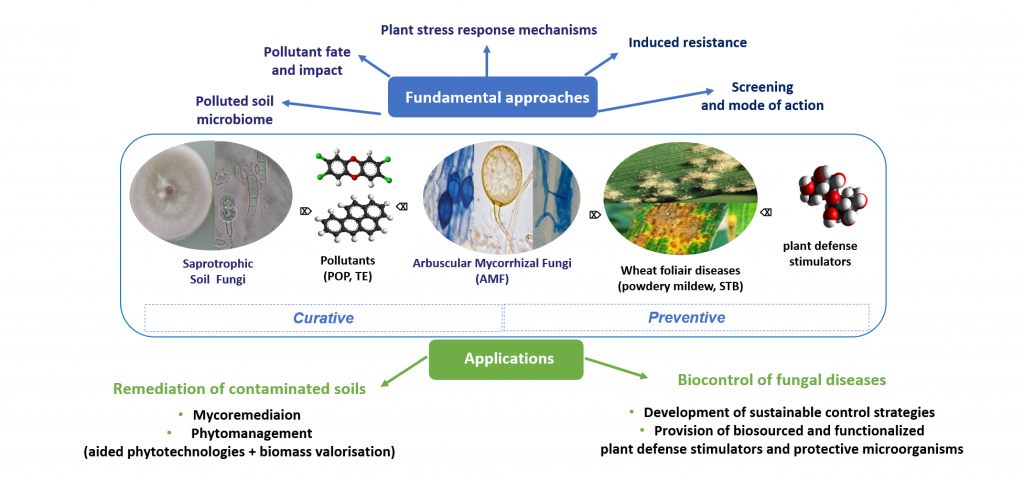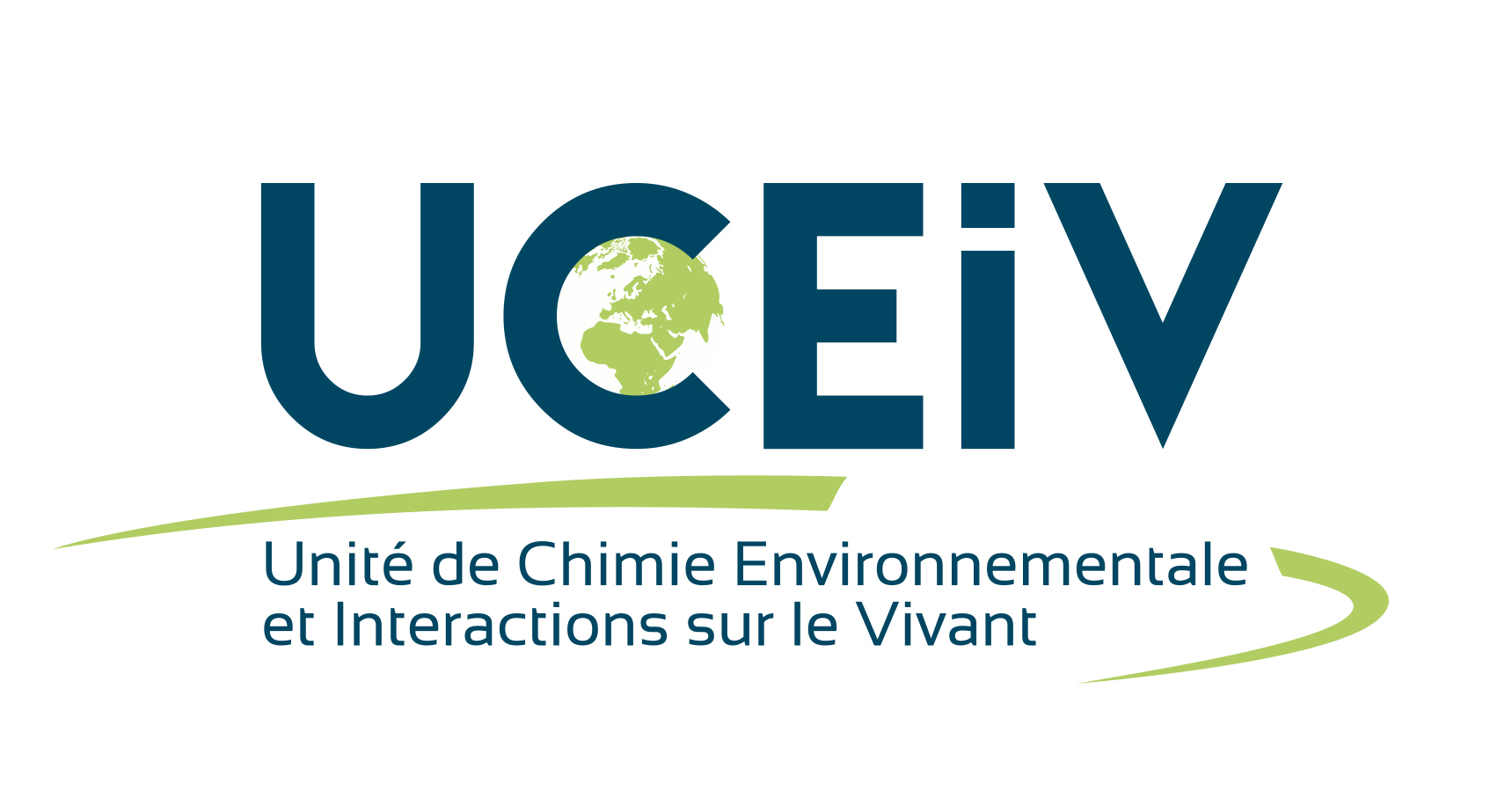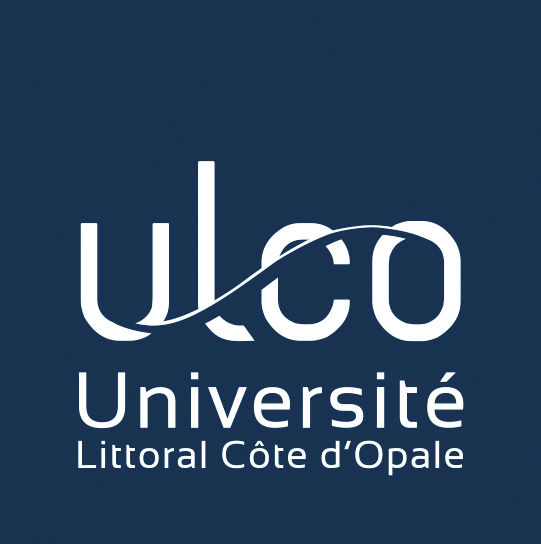Research activity
The IPCR team’s research activities are based on its expertise in mycology, in particular on the interactions between plants and fungi (phytopathogenic as well as symbiotic fungi), and in physiology, cytology, biochemistry, molecular biology and microbial ecology. They are organized in two main fields :

1 – Biocontrol of wheat foliar fungal diseases
This research theme aims to develop new biocontrol and sustainable control strategies against wheat fungal parasites, using Plant Defense Stimulants (PDSs) and/or beneficial bacterial (Plant Growth-Promoting Rhizobacteria) or fungal (Plant Growth-Promoting Fungi) microorganisms such as arbuscular mycorrhizal fungi and/or biostimulants in plant protection. Our studies focus on two pathosystems in particular, wheat/Blumeria graminis f.sp. tritici (agent of powdery mildew) and wheat/Zymoseptoria tritici (agent of septoria). The study of defense reactions in wheat and the optimization of the protective efficacy of SDPs in response to various environmental factors that may influence the establishment of such protection (wheat genotype, nutritional status of the plant, soil microbiota, climate change, etc.) are the main objectives of our work.
2- Phytomanagement and Bioremediation of contaminated soils.
This research theme aims to develop alternative, gentle and sustainable methods of remediation and management of contaminated soils.
In the case of phytomanagement, the feasibility, effectiveness and sustainability of the main phytotechnologies (phytostabilisation, phyto/rhizodegradation and phytoextraction) are being studied from the laboratory scale under controlled conditions to that of in situ workshop sites (demonstrators).
The aim is (1) to study the performance of different plant species and soil improvers, especially biological ones based on arbuscular mycorrhizal fungi, in the fate (mobility, transfer, dissipation) of organic pollutants (e.g., in the form of a fungus): PAHs, dioxins/furans, alkanes) and inorganic pollutants (trace elements), (2) to develop non-food channels for the valorisation of phytomass produced on polluted soils, (3) to monitor the influence of phytotechnologies on the refunctioning of contaminated soils, in particular via the characterisation of their microbiota and (4) to assess the environmental and health risks after treatment.
In a complementary way, bioremediation consists in exploiting, in particular, the diversity of saprotrophic fungi within the framework of the biodegradation of organic pollutants such as PAHs, dioxins/furans and emerging pollutants not only in the soil but also in other matrices (water, sediments, gaseous effluents, biogas). This work aims to study the mechanisms involved in the degradation of organic pollutants (availability, transport and incorporation, degradation), and the interest of using natural polysaccharides (modified starches) as solubilising agents for these pollutants.
Team members
PERMANENT STAFF | |
BOURDON-FACON Natacha | AI |
| CHEVALIER Wilfried | MCF |
Pr | |
LARUELLE Frédéric | IR |
PR | |
MCF | |
RAFIN Catherine | MCF-HDR |
MCF | |
IR | |
VEIGNIE Etienne | MCF |
NON-PERMANENT STAFF | |
Papa Mamadou Sitor NDOUR | Post-Doc |
Julien LANGRAND | ATER |
Scientific collaboration
Régionals :
- BioGAP, Institut Charles Viollette – ISA de Lille
- ProBIOGEM, Institut Charles Viollette –Université de Lille
- Laboratoire Génie Civil et géoEnvironnement, Université de Lille
- UMRT-INRAE 1158 BioEcoAgro – BIOPI – Université de Picardie Jules Verne
- Unité Transformations & Agroressources (ULR7519) – Université d’Artois
- UMR Transformation Intégrée de la Matière Renouvelable (TIMR), Ecole Supérieure de Chimie Organique et Minérale (ESCOM), Université de Technologie de Compiègne
- AGHYLE, Institut Polytechnique UniLaSalle, Beauvais
Nationals :
- Unité de Recherche Vigne et Vin de Champagne, URCA à Reims
- UMR Agroécologie, INRA de Dijon
- Unité Technologie Propres et Economie Circulaire (TPEC) – NERIS
- INRAE, SVQV, UMR A 1131 – Université de Strasbourg
Internationals :
- Laboratoire de Recherche en Développement Durable et Santé – Université Cadi Ayyad – Marrakech – Maroc
- Laboratoire Biotechnologie Végétale et Agrophysiologie des Symbioses – Université Cadi Ayyad – Marrakech – Maroc
- Laboratoire d’Amélioration Génétique des Plantes, Université d’Annaba (Algérie)
- Université des Sciences et de la Technologie Houari Boumédiène (USTHB, Algérie)
- Université de Djelfa (Algérie)
- Helmholtz Zentrum München – German Research Centre for Environmental Health, Institute of Soil Ecology, (Allemagne)
- Laboratory of Phytopathology, Université de Gand (Belgique)
- Unité de Chimie Biologique Industrielle, Université de Liège (Gembloux Agro Bio Tech) (Belgique)
- Laboratoire de Mycologie, Université de Louvain-la-Neuve (Belgique)
- Agriculture et Agroalimentaire (Ottawa)
- IRBV (Montréal)
- Université de Montréal (Canada)
- Faculté d’Agronomie, Université Saint-Esprit de Kaslik, université Libanaise (Liban)
- Université Vasile Alecsandri de Bacau, Roumanie
- Laboratoire de Génétique et Amélioration des Plantes, INAT de Tunis, Centre National de la Recherche en Agriculture Oasienne (Tunisie)
- Centre National de la Recherche en Agriculture Oasienne (Tunisie)
- Laboratory of Plant Pathology, Federal University of Santa Catarina, Florianópolis (Brésil).
Current Thesis
Prénom Nom | Période | Titre |
| Mathieu Delaeter | 2021-2024 | Development of specific molecular markers for resistance induction in wheat in response to mycorrhizal inoculation to control two fungal diseases: septoria and powdery mildew |
| Camille Carton | 2021-2024 | PROposition of new BIOsourced molecules of plant origin in the fight against plant diseases |
Mathie Craquelin | 2022-2025 | Chitosan and its derivatives: towards new biosourced active ingredients for biocontrol |
Paola Villanueva Rosales | 2023-2026 | Development of biostimulants for field crops and market gardening |
Research agreement
Internationals Projects
- 2021-2024 : PHC-TOUBKAL project : Contribution of mycorrhizal inoculation in the production of essential oils in some MAPs of the Marrakech region, in collaboration with a Moroccan partner: A. Qaddoury, Cadi Ayyad University.
- 2016-2021 : INTERREG V France-Flanders-Walloon project, ” Project portfolio : SMARTBIOCONTROL (26 partners from university laboratories, research centres or farmers’ unions).
- BIOSCREEN project: “New biosourced and multifunctional molecules for the control of phytopathogenic agents in crops in the cross-border region”. Some of them will be derived from CMA.
- BIOPROTECT project: “Biological protection in practice: optimisation of the effectiveness of (new) biological pesticides in the field”. Different CMA species will be tested for their protective potential against powdery mildew and septoria in wheat.
- 2016-2019 : ARIMNET – BACPLANTS project: Towards sustainable agriculture by increasing plant tolerance to biotic stress in the context of climate change (4 partners).
- 2017-2020 : CAPES-COFECUM “BIOSTIMALG” project: using algae for more sustainable agriculture. (2 partners)
Nationals Projects
- 2021-2024 : PIA – Programme d’Investissement d’Avenir – Ville Durable – Site du Crouy : Applied scientific and technical research project aimed at evaluating the relevance of using locally produced composts in the sustainable management of degraded soils in dense urban areas (5 partners).
- 2021-2024 : DEPHYTOP project (ADEME, APR GRAINE): Demonstrator of phytomanagement of soils contaminated by TMEs based on the circular economy: Optimisation of the essential oils sector (10 academic, private and institutional partners).
- 2017-2021 : PHYTEO project, Phytostabilization and Essential Oil (ADEME, APR GRAINE): Essential oil production: an eco-innovative pathway for the conversion of historically polluted soils (6 academic and private partners).
- 2018-2022 : EXTRA-Zn project (ADEME, APR GRAINE): ): Production of Zn-enriched biomasses by phytoextraction for ecocatalysis (4 partners).
- 2015-2018: IRIS+ project – FUI: Innovative solutions for the health of vines and wheat combining applications of biostimulants and SDP with imaging and agri-equipment technologies. (4 private partners, 3 academic partners)
Regionals Projects
- CPER BiHauts-Eco de France (2021-2027)
- CPER ECRIN (2021-2027)
- 2023-2025: MycUp Project (Stimule STIP Project): Zero residue valorisation of the lignocellulosic growth medium of edible fungi: use in biocontrol and biostimulation.
- 2022-2025 : PROZYMO project (Stimule project): Enzymatic production of new plant defence molecules.
- 2018-2024: MINIPEST project: Minimising the use of pesticides in arable and vegetable farming systems in Hauts-de-France. DEPHY EXPE project. (8 partners)
- 2016-2022 : CPER project « ALIBIOTECH Food and Biotechnology ».
WP 1. Characterization of the plant’s interaction with its environment
WP 2. Biological activities of biomolecules and secondary metabolites from plants and/or micro-organisms
- 2019–2021 : A2U project : ULCO/UPJV. Tripartite interaction as an alternative control method against powdery mildew and septoria in wheat, TRIPLET.
- 2022: VANIFUN project (SFR Condorcet): Evaluation of vanillin derivatives: application in plant protection against fungal pathogens.
- 2021 : PHYTOFONC project (SFR Condorcet): Contribution of organic amendments in the phytostabilisation of metallic trace elements and the refunctionalisation of the soil.
Private research contracts
- STOLZ industrial contract (2018, 2020): Monitoring the microbiological quality (fungi and bacteria) of animal meal during an innovative sterilisation process.
- LHOIST industrial contract (2019): Study of the antifungal properties, in vitro, of 2 products (Ca(OH)2 and CaCO3) on 3 phytopathogenic fungi of wheat.
Recent publications
- CARTON C., SAFRAN J., MOHANARAJ S., ROULARD R., DOMON J.M., BASSARD S., FACON N., TISSERANT B., MONGELARD G., GUTIERREZ L., RANDOUX B., MAGNIN-ROBERT M., PELLOUX J., PAU-ROBLOT C., and LOUNES HADJ SAHRAOUI A., Valorization of Sugar Beet Byproducts into Oligogalacturonides with Protective Activity against Wheat Powdery Mildew. Journal of Agricultural and Food Chemistry, 73(38):24237–24250, 2025. (10.1021/acs.jafc.5c05099). (hal-05266765).
- LANGRAND J., LOUNES HADJ SAHRAOUI A., SITOR NDOUR P.M., LARUELLE F., FACON N., and DUCLERCQ J., Angelica cultivation and mycorrhizal inoculation improve microbial diversity, functions and network complexity of trace elements-polluted soil: A three-year field study. Applied Soil Ecology, 210:106082, 2025. (10.1016/j.apsoil.2025.106082). (hal-05038614).
- LANGRAND J., FONTAINE J., TISSERANT B., LARUELLE F., FACON N., VERDIN A.,DEWAELE D., DUCLERCQ J., FLANQUART H., and LOUNES HADJ SAHRAOUI A., Relevance of Angelica cultivation for essential oil production in a phytomanagement strategy: a threeyear field study on an aged trace element -contaminated agricultural soil. Science of the Total Environment, 979:179485, 2025. (10.1016/j.scitotenv.2025.179485). (hal-05046297).
- BRETON E., MONCHY S., LUEN LI L., ELIAS F., COURCOT L., DUMAINE G., HENRY S., MICHAUD J., RAFIN C., SPILMONT N., ZIG L., and LAURENT S., Seafoams associated with phaeocystis sp. bloom accumulate saprophytic and parasitic microorganisms from terrestrial origin. Annales de la Societe Geologique du Nord, (32):2668, 2025. (10.54563/asgn.2668). (hal-05193535).
- ALLARIO T., KRZYZANIAK Y., MAGNIN-ROBERT M., TISSERANT B., FONTAINE J., COURTY P.E., MAIA-GRONDARD A., SIAH A., BALTENWECK R., HUGUENEY P.,RANDOUX B., and LOUNES HADJ SAHRAOUI A., Defense responses related to mycorrhizalinduced resistance in wheat against Zymoseptoria tritici. Biological Control, 203:105729, 2025. (10.1016/j.biocontrol.2025.105729). (hal-05142052).
- SITOR NDOUR P.M., BIDAR G., STAES L., FACON N., LARUELLE F., GENIES L, TISSERANT B., DUCLERCQ J., FONTAINE J., and LOUNES HADJ SAHRAOUI A., Effect of different composts on the dynamic of soil organic pollutants, microbial network interactions and multifunctionality in an urban garden made from a former brownfield. Journal of Environmental Management, 380:124951, 2025. (10.1016/j.jenvman.2025.124951). (hal-04994939).
- CARTON C., MAGNIN-ROBERT M., RANDOUX B., PAU-ROBLOT C., and LOUNES HADJ SAHRAOUI A., Potential of Bio-Sourced Oligogalacturonides in Crop Protection. Molecules, 30(6):1392, 2025. (10.3390/molecules30061392). (hal-05001310).
- SITOR NDOUR P.M., LANGRAND J., FONTAINE J., and LOUNES HADJ SAHRAOUI A., Exploring the significance of different amendments to improve phytoremediation efficiency: focus on soil ecosystem services. Environmental Science and Pollution Research, 32(2):485–513, 2025. (10.1007/s11356-024-35660-1). (hal-04981500).
- AKACHOUD O., BOUAMAMA H., LARUELLE F., FACON N., EL BROUDI S., HOUSSAYI S., ZOUBI B., BENKEBBOURA A., GHOULAM C., LOUNES HADJ SAHRAOUI A., and QADDOURY A., The developmental stage and arbuscular mycorrhizal symbiosis influence the essential oil yield, chemical profile, and biological activities in Thymus pallidus, T. satureioides, and Lavandula dentata. Industrial Crops and Products, 220:119188, 2024. (10.1016/j.indcrop.2024.119188). (hal-04660574).
- DUCOUSSO-DETREZ A., MORVAN S., FONTAINE J., HIRJRI M., and LOUNES HADJ SAHRAOUI A., How do high phosphate concentrations affect soil microbial communities after a century of ecosystem self-reclamation? Environmental Microbiology Reports, 16(5):1–23 /e70003, 2024. (10.1111/1758-2229.70003). (hal-04750664).
- LECONTE A., JACQUIN J., DUBAN M., DEWEER C., TRAPET P., LARUELLE F., FARCE A., COMPERE P., SAHMER K., FIEVET V., HOSTE A., SIAH A., ALOUNES HADJ SAHRAOUI A., JACQUES P., COUTTE F., DELEU M., and MUCHEMBLED J., Deciphering the mechanisms involved in reduced sensitivity to azoles and fengycin lipopeptide in Venturia inaequalis. Microbiological Research, 286:127816, 2024. (10.1016/j.micres.2024.127816). (hal-04634440).
- BENCHERIF K., TIFOUR M., Y. DALPE Y., and LOUNES HADJ SAHRAOUI A., Native arbuscular mycorrhizal inoculation enhances secondary metabolite contents in Tamarix gallica grown in saline soil. Symbiosis, 94:71–80, 2024. (10.1007/s13199-024-01015-0). (hal-04749401).
- FIRMIN S., HOUBEN D., FONTAINE J., LOUNES HADJ SAHRAOUI A., TRINSOUTROT- GATTIN I., and FAUCON M.P., MicroRNAs: An Emerging Class of Root Exudate Component of Wheat Response to Polluted Soil. Water, Air, and Soil Pollution, 235(9):564, 2024. (10.1007/s11270-024-07372-2). (hal-04665451).
- DELAETER M., MAGNIN-ROBERT M., RANDOUX B., and LOUNES HADJ SAHRAOUI A., Arbuscular Mycorrhizal Fungi as Biostimulant and Biocontrol Agents: A Review. Microorganisms, 12(7):1281, 2024. (10.3390/microorganisms12071281). (hal-04622186).
- OFORI-AGYEMANG F., BURGES A., WATERLOT C., LOUNES HADJ SAHRAOUI A., TISSERANT B., MENCH M., and OUSTRIERE N., Phytomanagement of a metal-contaminated agricultural soil with Sorghum bicolor near the former Pb/Zn Metaleurop Nord smelter. Chemosphere, 362:142624., 2024. (10.1016/j.chemosphere.2024.142624). (hal-04697553).
- CARTON C., SAFRAN J., LEMAIRE A., DOMON J.M., POELMANS W., BEECKMAN T., RAMOS-MARTIN F., ANTONIETTI V., SONNET P., LOUNES HADJ SAHRAOUI A., LEFEBVRE V., PELLOUX J., and PAU-ROBLOT C., Structural and biochemical characterization of SmoPG1, an exo-polygalacturonase from Selaginella moellendorffii. International Journal of Biological Macromolecules, 269(Part 2):131918, 2024. (10.1016/j.ijbiomac.2024.131918). (hal-04566706).
- DUCOUSSO-DETREZ A., LAHRACH Z., FONTAINEZ J., LOUNES-HADJ SAHRAOUI A., HIJRI M., Cultural techniques capture diverse phosphate-solubilizing bacteria in rock phosphate-enriched habitats. Frontiers in Microbiology, 2024, ⟨10.3389/fmicb.2024.1280848⟩. ⟨hal-04443174⟩
- OFORI-AGYEMANG F., WATERLOT C., MANU J., LALOGE R., FRANCIN R., PAPAZOGLOU E., ALEXOPOULOU E., LOUNES-HADJ SAHRAOUI A., TISSERAND B., MENCH M., BURGES A., OUSTIERE N., Plant testing with hemp and miscanthus to assess phytomanagement options including biostimulants and mycorrhizae on a metal-contaminated soil to provide biomass for sustainable biofuel production. Science of the Total Environment, 912, pp.169527, 2024. ⟨10.1016/j.scitotenv.2023.169527⟩. ⟨hal-04362740⟩
- AKACHOUD O., BOUAMAMA H., LARUELLE F., FACON N., EL BROUDI S., ZOUBI B., BENKEBBOURA A., GHOULAM C., LOUNES HADJ SAHRAOUI A., and QADDOURY A., Pedoclimatic conditions impact the mycorrhizal potential of the rhizospheric soil, essential oil yield, chemical profile, and biological activities in Lavandula dentata. Journal of Essential Oil Bearing Plants, 27(5):1204–1219, 2024. (10.1080/0972060X.2024.2401441). (hal-04716250).

